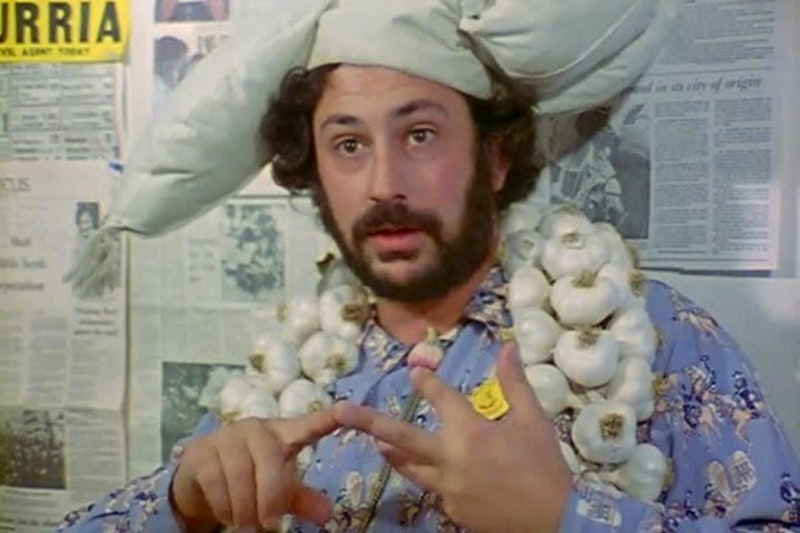American documentary filmmaker Les Blank is known for honest and authentic portrayals of people and situations they find themselves in. He delves into the cultures and traditions that have been in existence for centuries, and are perhaps on the verge of extinction. For example, in Burden of Dreams (1982), Blank captures the chaos and creativity of Werner Herzog’s making of Fitzcarraldo (1982). As much as Klaus Kinski’s madness and its effect on Herzog is captured on camera, Blank (wisely) focuses on the sheer feat of moving a ship across a mountain, or strange cultural norms and habits of the Peruvian indigenous tribes.
It’s this and Blank’s implicit affirmation of people’s dignity that brings elevation and illumination of the human condition. He doesn’t judge; he’s an observer who may or may not agree with his subjects. The warmth of his films comes from the fact that his camera doesn’t objectify the people but unfolds their life that would otherwise remain in the shadows.
Blank’s 1980 documentary, Garlic Is as Good as Ten Mothers, is an exploration of garlic—or as if often called, a “stinking rose”—as food, medicine, and culture itself. Blank shows portraits of different people, whose love of garlic is expressed in both unusual and common ways. “In everything Mama cooked—garlic,” says an elderly woman.
It seems bizarre and perhaps even dull to make a film about garlic. We take this bulbous plant for granted. Some love it, some hate it. Others revel in garlic’s curative powers (it’s a fact that consumption of raw garlic improves blood circulation, lowers blood pressure, and acts as an anti-viral and anti-microbial agent) and endless food possibilities. Garlic crosses the boundaries—Blank shows people from different cultures, races, and ethnicities quietly united in their celebration of garlic.
In between dancing the flamenco, an Andalusian gypsy tells stories of poverty in Spain during the Spanish Civil War. People had little but were able to grow garlic and tomatoes. He shows the ways garlic was eaten, praising this plant by the very action of peeling and cutting it, and putting it on a slice of bread with such gusto that his quirky madness and insistence on the significance of garlic is just a charm and not a disturbance.
There are garlic festivals, songs about garlic, even Alphonse Mucha-inspired art prints of women in nude and semi-nude poses, offering garlic as an aphrodisiac, or at the very least, something good to eat. Blank focuses much of his attention on California, specifically Berkeley. One of the subjects in the film is Lloyd John Harris, who wrote The Book of Garlic (1974), and founded the garlic festival, which continued to be a great annual tradition.
Harris is a bit eccentric. He wears a huge chef-like hat in a shape of a garlic clove, and talks about Berkeley as the center of action when it comes to natural living. It was a revolution or counter-revolution, depending how one looks at it, of farming and eating. It was a rejection of unnatural ways of consuming food. Although Blank doesn’t really mention this, it was also an implicit movement toward a more communal living.
Still, despite Harris’ silly garlic clove hat, he has many valuable and true things to say. Garlic isn’t just about health but about ways that people can connect and come to the table together. This can become an exercise in sentimentalism and nostalgia for some ways of the “old world,” yet at the same time, very quickly turning into a “free love” fest and Dionysian feast. In the documentary, a writer and journalist comments on how good it feels to hold garlic, peel and cook it, but cautiously adds, “But how do you say this without sounding like a hippie dipshit?”
What runs through this film (and through all of Blank’s films) is the seriousness and attention he gives to the subject. There’s an inherent sense of humor and a verve for life, and in Garlic Is as Good as Ten Mothers, this humor is especially evident. How does one react to people who are almost worshipping garlic? But is there something wrong with that?
Blank also talks to farmers in California, who are hardly hippies. One says that he’s not particularly “fanatical” about garlic but does grow it. He is, however, fanatical about bringing people real food to the table. Every person deserves this life-sustaining thing that crosses any cultural, racial, or ethnic boundaries.
There’s a theme that runs through the film—that humans can be connected through food. This isn’t about mindlessly ingesting garlic but preparing feasts that bring people together. If there happens to be a band (which it does in the film) playing accordion and pleasant sounds of mandolins, even better! Misery and joylessness aren’t accepted, only embrace of our humanity and mirth.

